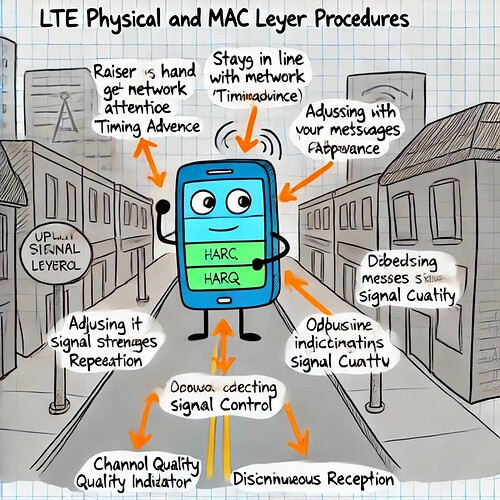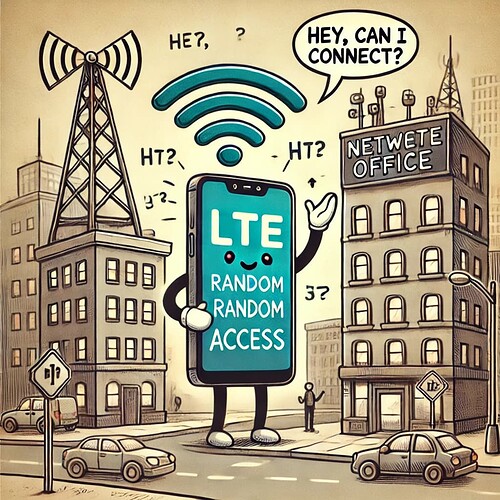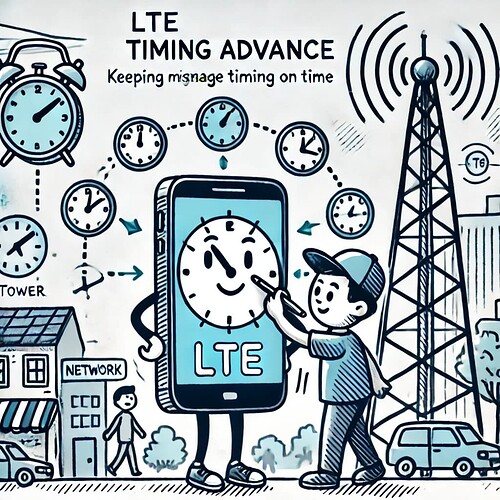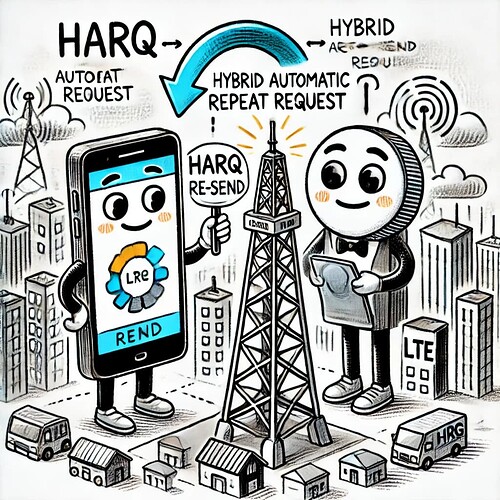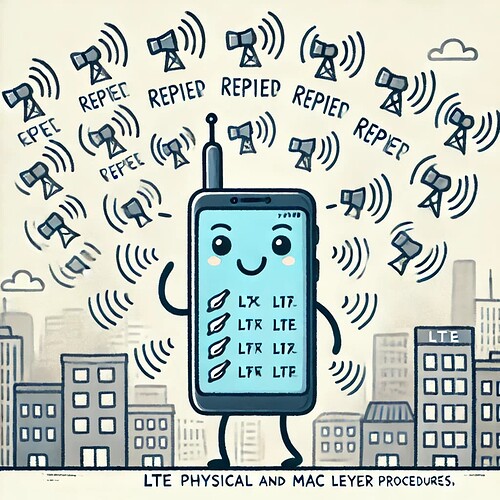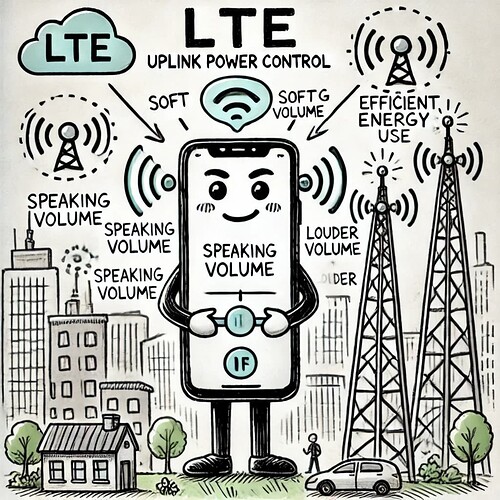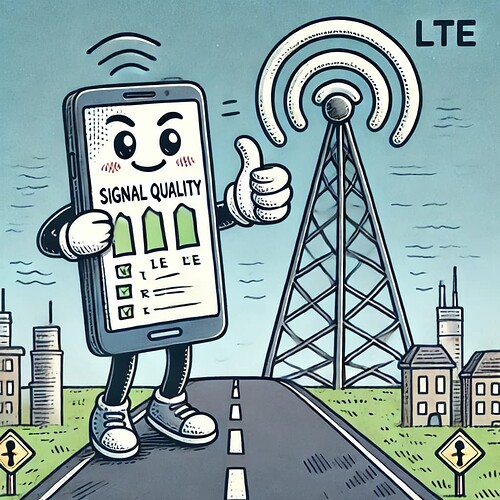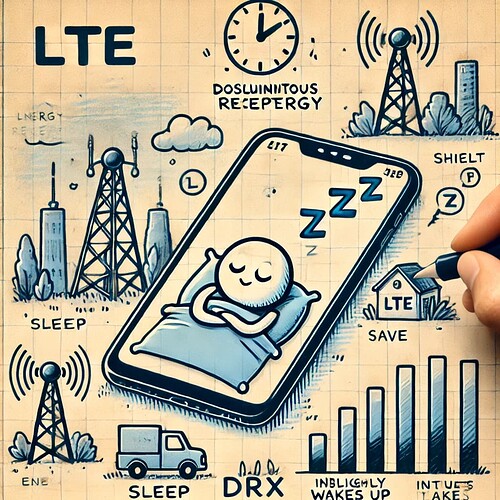This topic presents in a very simplified way all the main concepts that should be understood by those who know LTE.
LTE Physical and MAC Layer Procedures
The LTE Physical and MAC Layer Procedures ensure your phone connects smoothly to the network by coordinating communication timing, power levels, and message quality. Through processes like Random Access (getting the network’s attention), Timing Advance (synchronizing message timing), and Uplink Power Control (adjusting signal strength), your phone communicates efficiently. HARQ and Repetition confirm messages are received accurately by retrying if needed. Channel Quality Indicator (CQI) helps your phone inform the network about signal quality for optimal data flow, while Discontinuous Reception (DRX) allows your phone to save battery by “napping” but staying alert for important updates. Together, these procedures keep your connection stable, clear, and energy-efficient.
![]() In LTE, your phone follows a set of steps to talk to the network, like getting the best spot in the city. Random Access is like raising its hand to get noticed by the network. Timing Advance keeps your phone’s messages in sync, like staying in line with others. Uplink Power Control adjusts the phone’s “voice” to be just loud enough to reach the network without shouting. HARQ and Repetition are like double-checking messages so nothing important is missed. With Channel Quality Indicator, your phone tells the network if the signal is clear or fuzzy, so they can send data the best way. And with Discontinuous Reception (DRX), your phone saves energy by taking little naps, but it’s ready to wake up if something important comes in. All these steps help your phone stay connected, save power, and keep the connection strong!
In LTE, your phone follows a set of steps to talk to the network, like getting the best spot in the city. Random Access is like raising its hand to get noticed by the network. Timing Advance keeps your phone’s messages in sync, like staying in line with others. Uplink Power Control adjusts the phone’s “voice” to be just loud enough to reach the network without shouting. HARQ and Repetition are like double-checking messages so nothing important is missed. With Channel Quality Indicator, your phone tells the network if the signal is clear or fuzzy, so they can send data the best way. And with Discontinuous Reception (DRX), your phone saves energy by taking little naps, but it’s ready to wake up if something important comes in. All these steps help your phone stay connected, save power, and keep the connection strong!
Skip to: Roadmap to LTE
- Random Access
- Timing Advance
- HARQ
- Repetition
- Uplink Power Control
- Channel Quality Indicator
- Discontinuous Reception (DRX)
Random Access
Random access in LTE is the process that allows your phone to connect to the network for the first time or reconnect if there’s a break. It’s like asking for a chance to speak to establish a connection. (It’s the initial step your phone takes to connect with the network, ensuring it can start sending and receiving data).
![]() Imagine you’re in a busy city and want to get the attention of the main office (network). Random Access is like raising your hand and asking, “Hey, can I connect?”. Alternatively it is like knocking on a door to get someone’s attention. It helps your phone start talking with the network. It’s how your phone starts a conversation with the network, making sure it can connect and start talking.
Imagine you’re in a busy city and want to get the attention of the main office (network). Random Access is like raising your hand and asking, “Hey, can I connect?”. Alternatively it is like knocking on a door to get someone’s attention. It helps your phone start talking with the network. It’s how your phone starts a conversation with the network, making sure it can connect and start talking.
- Search Forum
 LTE Random Access
LTE Random Access 
Timing Advance
The network adjusts the timing of signals from your phone, especially important as you move farther from the tower. It’s like giving directions to keep messages arriving on time. It adjusts the timing of signals sent from your phone so they reach the cell tower perfectly synchronized, avoiding collisions with other signals.
![]() This is like the city telling your phone when to send its messages so they arrive on time, not too early or too late. It’s as if the network is adjusting your watch so your messages arrive precisely on schedule. Alternatively it s like setting off early to make sure you arrive at a party on time. It adjusts the timing of signals from your phone so they reach the network’s tower right on schedule, avoiding signal traffic jams.
This is like the city telling your phone when to send its messages so they arrive on time, not too early or too late. It’s as if the network is adjusting your watch so your messages arrive precisely on schedule. Alternatively it s like setting off early to make sure you arrive at a party on time. It adjusts the timing of signals from your phone so they reach the network’s tower right on schedule, avoiding signal traffic jams.
- Search Forum
 LTE Timing Advance
LTE Timing Advance 
HARQ
![]() resources or skipt to:
resources or skipt to: ![]()
Description (tbd)
![]() Analogy (tbd)
Analogy (tbd)
HARQ helps improve data reliability by requesting re-sends if data is unclear. This ensures that any missed information gets another chance, keeping the connection stable. Like a built-in error checker. When your phone sends data, the network checks it for errors. If any issues are found, the network requests a repeat transmission, ensuring data is received correctly.
![]() Think of HARQ as a way to make sure messages are delivered correctly. If something’s missing or unclear, the city asks your phone to repeat it, just like asking someone to repeat themselves in a conversation. Like a spell-check for your messages. When your phone sends data, the network checks for mistakes. If it finds any, it asks your phone to send the message again until it’s correct.
Think of HARQ as a way to make sure messages are delivered correctly. If something’s missing or unclear, the city asks your phone to repeat it, just like asking someone to repeat themselves in a conversation. Like a spell-check for your messages. When your phone sends data, the network checks for mistakes. If it finds any, it asks your phone to send the message again until it’s correct.
- Search Forum
 LTE HARQ
LTE HARQ 
Repetition
For better reliability in weak signal areas, the network can repeat messages to ensure they’re received correctly. It’s like saying something twice to make sure it’s heard. Repetition in LTE involves sending the same data multiple times to increase the chances of it being received correctly. It’s like repeating yourself in a noisy room to make sure the other person hears you clearly.
![]() Sometimes, to make sure the message is extra clear, the network asks your phone to say it multiple times. It’s like saying your message a few times in a noisy place so everyone understands perfectly. Repetition means your phone might say the same thing a few times to make sure it’s heard clearly. It’s like repeating directions in a noisy room to ensure everyone understands.
Sometimes, to make sure the message is extra clear, the network asks your phone to say it multiple times. It’s like saying your message a few times in a noisy place so everyone understands perfectly. Repetition means your phone might say the same thing a few times to make sure it’s heard clearly. It’s like repeating directions in a noisy room to ensure everyone understands.
- Search Forum
 LTE Repetition
LTE Repetition 
Uplink Power Control
The network manages how much power your phone uses to send signals, ensuring it’s strong enough to reach the tower without causing interference. This keeps connections efficient and reduces battery drain. It ensures your phone sends signals at the right power level to maintain a clear and efficient connection with the network.
![]() This is how the network helps your phone adjust its speaking volume, like adjusting your speaking volume depending on how far away the listener is. If it’s close to the tower, it speaks softly; if far, it speaks louder. This keeps messages clear without draining too much energy. (Adjusting your voice when talking to someone across a room). It makes sure your phone sends signals at just the right volume, so the network hears them clearly without wasting energy.
This is how the network helps your phone adjust its speaking volume, like adjusting your speaking volume depending on how far away the listener is. If it’s close to the tower, it speaks softly; if far, it speaks louder. This keeps messages clear without draining too much energy. (Adjusting your voice when talking to someone across a room). It makes sure your phone sends signals at just the right volume, so the network hears them clearly without wasting energy.
- Search Forum
 LTE Uplink Power Control
LTE Uplink Power Control 
Channel Quality Indicator
Your phone regularly sends updates about signal Quality to the network. This feedback helps adjust data speed and improve connection quality. It provides feedback on the quality of the signal, helping the network adjust its settings for optimal performance.
![]() Think of CQI as your phone telling the network how good the roads (signal quality) are - like your phone giving the network a report card on how good the connection is. This helps the network decide the best way to send data back to your phone, using the smoothest, fastest roads possible. CQI is like your phone giving the network a thumbs-up or thumbs-down on how well it can hear. It helps the network know if it needs to speak louder or clearer.
Think of CQI as your phone telling the network how good the roads (signal quality) are - like your phone giving the network a report card on how good the connection is. This helps the network decide the best way to send data back to your phone, using the smoothest, fastest roads possible. CQI is like your phone giving the network a thumbs-up or thumbs-down on how well it can hear. It helps the network know if it needs to speak louder or clearer.
- Search Forum
 LTE Channel Quality Indicator (CQI)
LTE Channel Quality Indicator (CQI) 
Discontinuous Reception (DRX)
DRX allows your phone to save battery by “sleeping” during times of low activity, only waking up at intervals to check for updates. This helps extend battery life without missing important information. It allows your phone to enter a low-power state when not actively receiving data, conserving battery while staying ready to wake up when needed.
![]() DRX is like your phone taking little naps to save energy but waking up to check for important messages (taking short naps between tasks to save energy). It helps save battery by resting while still being alert for important updates. It lets your phone go into a low-power sleep mode when it’s not receiving data, saving battery while staying ready to wake up when needed.
DRX is like your phone taking little naps to save energy but waking up to check for important messages (taking short naps between tasks to save energy). It helps save battery by resting while still being alert for important updates. It lets your phone go into a low-power sleep mode when it’s not receiving data, saving battery while staying ready to wake up when needed.
- Search Forum
 LTE Discontinuous Reception (DRX)
LTE Discontinuous Reception (DRX) 
That’s it. ![]()
-
Continue reading: Roadmap to LTE - Protocol Stacks
-
Or back to: Roadmap to LTE
